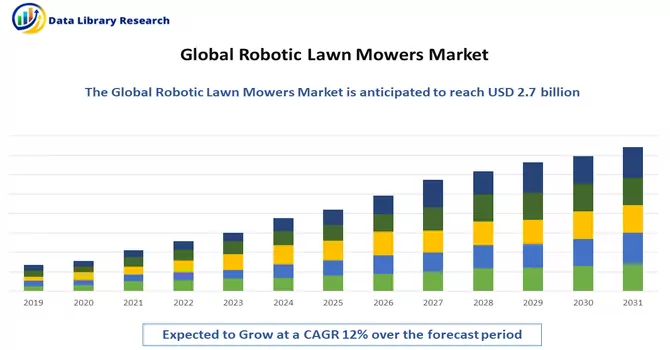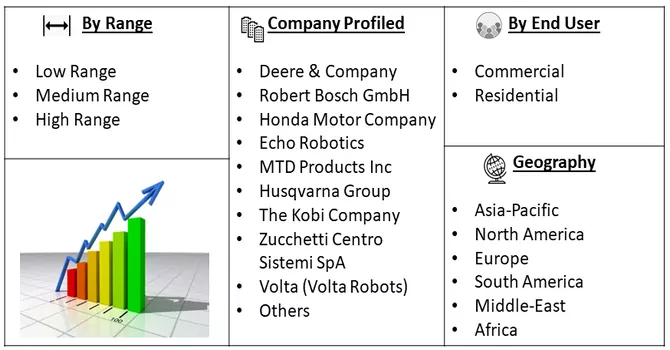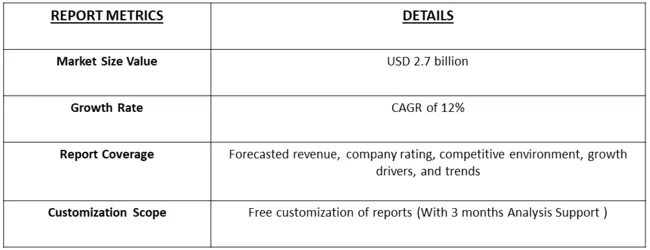The robotic lawn mower market size was valued at USD 2.7 billion in 2023, and it is anticipated to register a CAGR of about 12% during the forecast period (2024 - 2031).

Get Complete Analysis Of The Report - Download Free Sample PDF
An automatic lawn mower, also known as a robotic or robot lawn mower, is a self-operating, autonomous device designed for the purpose of cutting grass and maintaining lawns without direct human intervention. These devices utilize advanced technologies such as sensors, navigation systems, and programming to move around a designated lawn area, detect obstacles, and systematically trim the grass to a specified height. Automatic lawn mowers are equipped with features like collision avoidance sensors, and boundary-setting capabilities, and often operate using rechargeable batteries. They offer homeowners a hands-free and time-saving alternative to traditional manual lawn mowing, providing an efficient and convenient solution for maintaining well-kept lawns.
The automatic lawn mower market is experiencing robust growth fueled by several key factors. The inherent time efficiency and convenience offered by these autonomous devices, relieving homeowners from manual lawn mowing tasks, contribute significantly to their popularity. The integration of advanced smart technologies, including GPS and sensors, enhances navigation and obstacle avoidance capabilities, aligning with the broader trend of smart home adoption. Environmental awareness and the eco-friendly nature of electric and battery-powered models appeal to environmentally conscious consumers. Labor shortages, changing lifestyles, advancements in battery technology, ongoing product innovation, and increased affordability collectively contribute to the expanding market for automatic lawn mowers. As these devices continue to evolve, offering improved performance and additional features, they represent a growing segment within the broader landscape of smart and efficient home solutions.
Market Segmentation: The Global Automatic Lawn Mower Market and is segmented by Range (Low Range, Medium Range, and High Range),End User (Commercial and Residential), and Geography (North America, Europe, Asia-Pacific, and Rest of the World). The report offers market size and forecasts for the Robotic Lawn Market in value (USD Billion) for all the above segments.

For Detailed Market Segmentation - Download Free Sample PDF
The robotic lawn mower market is witnessing notable trends that reflect the evolving landscape of automated lawn care solutions. A key trend is the increasing integration of advanced technologies, such as artificial intelligence and connectivity features, enhancing the overall efficiency and smart capabilities of these devices. Additionally, there is a growing emphasis on sustainability, with manufacturers focusing on eco-friendly designs and energy-efficient operations. The market is also experiencing a shift towards user-friendly interfaces, making robotic lawn mowers more accessible to a broader consumer base. As smart home adoption rises, seamless integration with home automation systems is becoming a standard, enabling users to control and monitor their robotic mowers remotely. Furthermore, the market is characterized by continuous product innovation, with manufacturers introducing models with improved navigation, enhanced cutting capabilities, and longer battery life. Overall, the trends in the robotic lawn mower market underscore a trajectory towards technologically advanced, environmentally conscious, and user-centric solutions for modern lawn maintenance.
Market Drivers:
Growing Demand for Smart Home Solutions
The burgeoning acceptance of smart home technologies stands out as a pivotal catalyst propelling the robotic lawn mower market forward. Homeowners, driven by a desire for cohesive and automated solutions across diverse household tasks, are fueling a heightened demand for robotic lawn mowers seamlessly integrating into smart home ecosystems. This escalating trend is underscored by the convenience afforded to users who can remotely control and monitor these devices through smartphones and various smart home platforms. The seamless integration of robotic lawn mowers into the fabric of smart homes not only meets the evolving expectations of tech-savvy consumers but also serves as a key contributor to the sustained expansion of the market, reflecting a broader shift towards interconnected and intelligent living spaces.
Focus on Sustainable and Eco-Friendly Practices
A prominent force propelling the robotic lawn mower market is the increasing focus on sustainability and environmentally friendly approaches to lawn care. As consumers become more attuned to environmental issues, there is a notable shift towards choosing battery-powered and electric robotic mowers over traditional gas-powered counterparts, thereby diminishing carbon emissions. The eco-conscious attributes of these devices align seamlessly with the overarching trend of environmentally aware lifestyles, contributing significantly to the surge in demand for robotic lawn mowers. This preference for sustainable lawn care practices not only reflects a growing environmental consciousness among consumers but also underscores the pivotal role that robotic mowers play in fostering a greener and more ecologically responsible approach to home and garden maintenance.
Market Restraints:
High Initial Cost
A significant impediment in the robotic lawn mower market lies in the comparatively elevated initial costs associated with these devices in contrast to traditional lawn mowers. The incorporation of advanced technologies, sensors, and automation features contributes to the upfront expenses of robotic mowers. This pricing hurdle can act as a deterrent to adoption for certain consumers, particularly in regions where budget constraints play a decisive role in purchasing decisions. The challenge of affordability emerges as a critical factor that needs addressing for the widespread penetration and enduring growth of the robotic lawn mower sector. To overcome this restraint, industry stakeholders must explore avenues to make these innovative devices more accessible and cost-effective, ensuring broader market reach and fostering increased adoption among a diverse consumer base.
The COVID-19 pandemic has had a nuanced impact on the robotic lawn mower market. While the initial stages of the pandemic led to disruptions in manufacturing, supply chain challenges, and economic uncertainties, the market exhibited resilience and adaptability. As lockdowns and social distancing measures prompted a surge in home-centric activities, there was an increased focus on home improvement and automation. This trend positively influenced the robotic lawn mower market as homeowners sought efficient and autonomous solutions for lawn maintenance while spending more time at home. Additionally, the growing interest in smart home technologies during the pandemic further boosted the appeal of robotic lawn mowers. On the flip side, economic uncertainties and financial constraints in some regions may have slowed down purchasing decisions for these relatively high-end devices. Overall, the COVID-19 impact on the robotic lawn mower market reflects a mix of challenges and opportunities, with changing consumer behaviours shaping the market dynamics.
Segmental Analysis:
Medium Segment is Expected to Witness Significant Growth Over the Forecast Period
The term "medium-range robotic lawn mower" typically refers to robotic mowers that fall within a moderate price range and possess a balanced set of features suitable for average-sized lawns. These medium-range robotic lawn mowers are designed to offer a cost-effective yet efficient solution for homeowners seeking automation in lawn care. They often come equipped with advanced features such as GPS navigation, obstacle detection, and mobile app connectivity, allowing users to control and monitor the mower remotely. Medium-range models strike a balance between affordability and functionality, making them accessible to a broader consumer base. These robotic mowers are well-suited for lawns of moderate size, providing automated cutting, scheduling, and efficient coverage to simplify lawn maintenance tasks for users.
Commercial Segment is Expected to Witness Significant Growth Over the Forecast Period
The commercial segment within the robotic lawn mower market caters to businesses and enterprises seeking automated solutions for large-scale lawn maintenance. Commercial robotic lawn mowers are designed to handle expansive areas such as golf courses, sports fields, parks, and institutional landscapes. These high-capacity robotic mowers are equipped with advanced features like GPS-guided navigation, obstacle detection, and sophisticated cutting patterns to efficiently cover substantial grounds. The commercial segment addresses the growing demand for labor-saving and cost-effective alternatives in professional landscaping and grounds maintenance. Businesses benefit from the reduced need for manual labor, increased productivity, and the ability to maintain well-groomed and manicured landscapes consistently. As the commercial robotic lawn mower market evolves, it reflects a shift in the commercial landscaping sector towards embracing automation and smart technologies for efficient and sustainable grounds management.
North America Region is Expected to Witness Significant Growth Over the Forecast Period
North America stands as a prominent and dynamic market for robotic lawn mowers, experiencing significant growth and adoption in recent years. The region's increasing affinity for smart home technologies and automation has driven the demand for robotic lawn mowers as homeowners seek efficient and time-saving solutions for lawn maintenance. The United States and Canada, in particular, are witnessing a surge in the popularity of these devices. The temperate climate and the prevalence of suburban lawns contribute to the appeal of robotic mowers as they offer an automated and hands-free alternative to traditional lawn care methods. The North American robotic lawn mower market is characterized by a competitive landscape with various manufacturers offering diverse models catering to different lawn sizes and functionalities.
The market's growth is further fueled by the region's emphasis on sustainability and eco-friendly practices, aligning with the environmental consciousness of consumers. The adoption of battery-powered and electric robotic mowers has gained traction, reflecting a commitment to reducing carbon emissions associated with traditional gas-powered alternatives. Moreover, the ongoing advancements in technology, such as improved sensors, GPS navigation, and connectivity features, contribute to the attractiveness of robotic lawn mowers in North America. As smart home ecosystems become more prevalent, the seamless integration of robotic mowers into these systems enhances user convenience and drives market growth. While the COVID-19 pandemic initially posed challenges to various industries, including manufacturing and supply chains, the robotic lawn mower market in North America displayed resilience. The pandemic-induced shift towards remote work and increased focus on home activities further accelerated the interest in home automation and smart lawn care solutions. Thus, North America presents a thriving landscape for the robotic lawn mower market, marked by technological innovation, sustainability considerations, and a growing appreciation for automated solutions in residential lawn maintenance. The region's market trajectory indicates a sustained demand for these devices as they become integral components of modern, connected homes.

Get Complete Analysis Of The Report - Download Free Sample PDF
The analyzed market exhibits a high degree of fragmentation, primarily attributable to the presence of numerous players operating on both a global and regional scale. The competitive landscape is characterized by a diverse array of companies, each contributing to the overall market dynamics. This fragmentation arises from the existence of specialized solution providers, established industry players, and emerging entrants, all vying for market share. The diversity in market participants is underscored by the adoption of various strategies aimed at expanding the company presence. On a global scale, companies within the studied market are strategically positioning themselves through aggressive expansion initiatives. This often involves entering new geographical regions, targeting untapped markets, and establishing a robust global footprint. The pursuit of global expansion is driven by the recognition of diverse market opportunities and the desire to capitalize on emerging trends and demands across different regions. Simultaneously, at the regional level, companies are tailoring their approaches to align with local market dynamics. Regional players are leveraging their understanding of specific market nuances, regulatory environments, and consumer preferences to gain a competitive edge. This regional focus allows companies to cater to the unique needs of local clientele, fostering stronger market penetration. To navigate the complexities of the fragmented market, companies are implementing a range of strategies. These strategies include investments in research and development to stay at the forefront of technological advancements, mergers and acquisitions to consolidate market share, strategic partnerships for synergies, and innovation to differentiate products and services. The adoption of such multifaceted strategies reflects the competitive nature of the market, with participants continually seeking avenues for growth and sustainability. In essence, the high fragmentation in the studied market not only signifies the diversity of players but also underscores the dynamism and competitiveness that drive ongoing strategic maneuvers. As companies explore various avenues for expansion, the market continues to evolve, presenting both challenges and opportunities for industry stakeholders.
Some of the key market players working in this segment are:
Recent Development:
1) In May 2022, Mammotion, an innovative electric robotics tools manufacturer, unveiled its groundbreaking product, LUBA – a perimeter wire-free robot lawn mower, marking a significant leap in residential lawn care technology. LUBA represents a transformative approach to home lawn maintenance, aiming to replace traditional gas-powered push and ride-on mowers, as well as existing robotic mowers that rely on perimeter cables. This smart robotic mower from Mammotion introduces a wire-free solution, enhancing convenience and simplifying the operation for homeowners. The introduction of LUBA reflects a strategic move towards sustainability and user-friendly design, addressing the evolving needs of residential lawn care.
2) In May 2022, Toro made waves in the residential yard care category by launching its advanced robotic mower, incorporating cutting-edge technology and innovative features. This battery-powered mower from Toro not only signifies a milestone in smart and connected home technology but also draws on the company's rich legacy of delivering inventive solutions for outdoor environments over more than a century. The Toro robotic mower is designed to provide homeowners with an easy-to-use, technologically sophisticated solution for maintaining their yards, contributing to the modernization of residential lawn care practices. These introductions from both Mammotion and Toro underscore a broader industry trend towards more sustainable, user-friendly, and technologically advanced solutions in the realm of home lawn maintenance.
Q1. What was the Robotic Lawn Mowers Market size in 2023?
As per Data Library Research the robotic lawn mower market size was valued at USD 2.7 billion in 2023.
Q2. At what CAGR is the Robotic Lawn Mowers market projected to grow within the forecast period?
Robotic Lawn Mowers Market is anticipated to register a CAGR of about 12% during the forecast period.
Q3. What are the Growth Drivers of the Robotic Lawn Mowers Market?
Growing Demand for Smart Home Solutions and Focus on Sustainable and Eco-Friendly Practices are the Growth Drivers of the Robotic Lawn Mowers Market.
Q4. Which Region is expected to hold the highest Market share?
North America region is expected to hold the highest Market share.
Data Library Research are conducted by industry experts who offer insight on industry structure, market segmentations technology assessment and competitive landscape (CL), and penetration, as well as on emerging trends. Their analysis is based on primary interviews (~ 80%) and secondary research (~ 20%) as well as years of professional expertise in their respective industries. Adding to this, by analysing historical trends and current market positions, our analysts predict where the market will be headed for the next five years. Furthermore, the varying trends of segment & categories geographically presented are also studied and the estimated based on the primary & secondary research.
In this particular report from the supply side Data Library Research has conducted primary surveys (interviews) with the key level executives (VP, CEO’s, Marketing Director, Business Development Manager and SOFT) of the companies that active & prominent as well as the midsized organization
FIGURE 1: DLR RESEARH PROCESS

Extensive primary research was conducted to gain a deeper insight of the market and industry performance. The analysis is based on both primary and secondary research as well as years of professional expertise in the respective industries.
In addition to analysing current and historical trends, our analysts predict where the market is headed over the next five years.
It varies by segment for these categories geographically presented in the list of market tables. Speaking about this particular report we have conducted primary surveys (interviews) with the key level executives (VP, CEO’s, Marketing Director, Business Development Manager and many more) of the major players active in the market.
Secondary ResearchSecondary research was mainly used to collect and identify information useful for the extensive, technical, market-oriented, and Friend’s study of the Global Extra Neutral Alcohol. It was also used to obtain key information about major players, market classification and segmentation according to the industry trends, geographical markets, and developments related to the market and technology perspectives. For this study, analysts have gathered information from various credible sources, such as annual reports, sec filings, journals, white papers, SOFT presentations, and company web sites.
Market Size EstimationBoth, top-down and bottom-up approaches were used to estimate and validate the size of the Global market and to estimate the size of various other dependent submarkets in the overall Extra Neutral Alcohol. The key players in the market were identified through secondary research and their market contributions in the respective geographies were determined through primary and secondary research.
Forecast Model
